Monday 2nd February – Fleets Dam – The amount of water roaring over the weir has increased. The large log has gone. Water pours out of culverts set into the concrete walls that lead to the bridge over Old Mill Lane. Further along, water is draining from a large pool that has formed at the bottom of a paddock. It is easy to see how rivers can rise so rapidly and to such a great extent when one can see the volume of water entering the Dearne in so short a stretch. On the lake there are over 130 Black-headed Gulls. A flock of fifty take off from the old jetty and head north-east. Four Goosander, three females and a male, glide on the far side. Mallard drift in the centre of the lake. A Cormorant flies over. Under a large Willow by the river is a massive worked piece of stone, shaped somewhat like an old telephone hand piece. A rusty metal rod is embedded into the rock. A Song Thrush sings despite the steadily falling rain. A Bullfinch flies off into the undergrowth.
Tuesday 3rd February – Grange Gate – Steel grey clouds scud across a pale grey sky. Robins are singing. A lonely Redwing sits atop a tall Hawthorn seemingly looking for companions, but most of the winter thrushes have left. A silent Green Woodpecker flies over the pastures near the river. A Great Tit sings like a never-endingly spinning rusty cycle wheel. Yellowhammers fly down the hill as we rise steadily towards the viaduct. Dill the Dog seems to be having the time of her life – rushing too and fro, rolling in wet grass and getting covered in mud. (She later pays for it by stiffening up and being hardly able to move her back legs.) A Blue Tit is working away at a trunk, wheedling out a hidden morsel. Fourteen Magpies form a Parliament in a tree. I manage to slide down a bank on my back into a muddy pool – I can hardly criticise Dill the Dog now for the state she is in.
Thursday 5th February – Worsbrough Reservoir – The willow crop near the old railway is now twelve feet high. I am unsure of the situation regarding using willow as a “green” energy source. Backing has been withdrawn for the scheme and it may (or may soon) collapse. Given the millions that have been poured into gas-fired power stations that have a relatively short life before the fuel runs out, it seems short-sighted at least. Great and Blue Tits are numerous and noisy. Robins sing loudly. Drake Mallards are chasing the ducks, usually mob-handed. There are several Great Crested Grebes on the reservoir, still in winter plumage, but few other wildfowl. Eventually, I find seven Tufted Duck, but no Pochard which were once omnipresent winter visitors. A large flock of Black-headed Gulls flies around. One Blackthorn is in blossom. The willow carr is flooded and water wells up into it, presumably draining off the fields which are at a higher level. Food in the form of seed and fat balls has been hung from the Hawthorn hedge that runs beside the path along the south of the reservoir. At another flooded area, a Chaffinch calls pink pink loudly from a tree and a Treecreeper mouses its way up another. Cuckoo Pint leaves, like large arrows, are abundant in the damp areas under bushes. A Grey Heron stands on a buoy, occasionally being dive-bombed by a gull. Another Grey Heron stands strangely on the railings along the path over the dam, many feet above the water. Three Mute Swans are on the river below the dam and overflow weirs.
Friday 6th February – Willowbank – The area is still sodden throughout. The pussy willow blossom is just beginning to emerge. Fields beside the Dearne still contain pools of water and the area up the valley from the loop is flooded, although not to a great extent. Song Thrushes are in full song.
Sunday 8th February – Wombwell Ings – A gale roars down the valley from the north-west and howls through the trees. There is a bank of cloud to the south, but overhead it is clear blue sky and the sun is bright. However, the wind chill factor is considerable and my ears are painfully cold. A large mixed goose flock occupies the rough pasture – Canada Geese, Greylags and a few Pink-footed Geese. Beside the ings is a large flock of Wigeon moving slowly onto the grass areas to graze. Further along, a large Golden Plover flock stands, some with their black-bellied breeding plumage. Three Shelduck and a Goosander are preening on the water. There are very few Lapwings, which is surprising.
Wednesday 11th February – Fleets Dam – Another February day; grey and damp. The whole area has a slight odour of decay and rottenness about it. A few Black-headed Gulls grace the lake. The pastures between the old railway and the River Dearne are still flooded – I would have thought a small drainage ditch would have been dug. A flock of Siskin twitter excitedly in the trees – yellow-green plumage with a toupée of black. A cock Bullfinch pecks at buds on a bush. Long-tailed Tits tumble like trapeze artists.
Friday 13th February – Fleets Dam – And the grey and damp continues. A Sparrowhawk glides across the lake and over towards the Wakefield Road. The Song Thrush has taken up residence at the top of an Elder and is singing loudly as usual. Blue and Great Tits chirrup and dance among the branches. Shoots of green are appearing on Elders.
Huddersfield Road – A wall separates an old quarry from the road, just out of town. The Barnsley – Penistone – Huddersfield railway line runs past here and under the road. Ivy clings to the top of the bank and the wall and is covered in ripening berries. Privet, bare of leaves, also sports shiny black fruits. These will be welcomed by thrushes especially as a food source at a difficult time of year for them.
Saturday 14th February – Hodsock Priory, Nottinghamshire – A 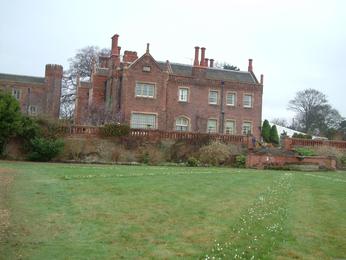 country house near Blyth in Nottinghamshire that never was a priory and why it is called that now is unclear to me. The site has been occupied from the Bronze Age. After the Norman Conquest, Hodsock was farmed by a Saxon called Ulsi under the Norman overlord, Roger de Busli of Tickhill Castle. Through the daughter of de Busli’s liegeman Torald de Lizours, the estate became the property of Roger de Cresci in the reign of Henry II (1154-89). In the reign of Henry IV (1399-1413) the estate passed by marriage to the Cliftons and remained there for 14 generations. However, after the English Civil War they had left
country house near Blyth in Nottinghamshire that never was a priory and why it is called that now is unclear to me. The site has been occupied from the Bronze Age. After the Norman Conquest, Hodsock was farmed by a Saxon called Ulsi under the Norman overlord, Roger de Busli of Tickhill Castle. Through the daughter of de Busli’s liegeman Torald de Lizours, the estate became the property of Roger de Cresci in the reign of Henry II (1154-89). In the reign of Henry IV (1399-1413) the estate passed by marriage to the Cliftons and remained there for 14 generations. However, after the English Civil War they had left 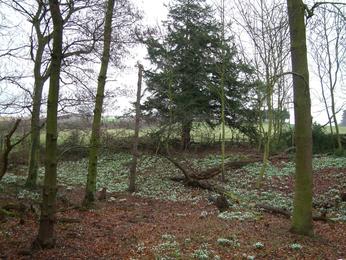 Hodstock and it was a farmhouse. In 1765 it was sold to the Mellish family who were merchants. The house was rebuilt in the early 1830, with the south wing being designed by the Gothic Revivalist, Ambrose Poynter. The terrace was also laid out at the time in the Italian style. Hodsock remains in the hands of descendants of the Mellish family. The gatehouse was previously used as a laundry and a large iron stove remains there. It heated the room and clothes were hung from racks that were on pulleys to raise them to the ceiling. Cherry blossom is out in the gardens, pinks, reds and white. A large lead water butt stands by the garden wall nicely embellished, including the logo WJM 1778. Further round into the gardens is the reconstruction of a Victorian Apiary with various types of beehive. There are numerous fine plant and tree specimens, including a False Acacia with a splendid bark pattern. The tour goes into the woodlands for a display for which Hodstock Priory is primarily known – its Snowdrops. They are everywhere and form great drifts of white stretching out under the trees. Chaffinches are abundant here and Robin song is constant. Out on the fields, moles have been very active. Small water smoothed pebbles have been pushed to the surface by the molehills. A large skein of geese passes some way to the north, ever changing through endless variations on a V. Eighteen Fieldfare fly over, calling.
Hodstock and it was a farmhouse. In 1765 it was sold to the Mellish family who were merchants. The house was rebuilt in the early 1830, with the south wing being designed by the Gothic Revivalist, Ambrose Poynter. The terrace was also laid out at the time in the Italian style. Hodsock remains in the hands of descendants of the Mellish family. The gatehouse was previously used as a laundry and a large iron stove remains there. It heated the room and clothes were hung from racks that were on pulleys to raise them to the ceiling. Cherry blossom is out in the gardens, pinks, reds and white. A large lead water butt stands by the garden wall nicely embellished, including the logo WJM 1778. Further round into the gardens is the reconstruction of a Victorian Apiary with various types of beehive. There are numerous fine plant and tree specimens, including a False Acacia with a splendid bark pattern. The tour goes into the woodlands for a display for which Hodstock Priory is primarily known – its Snowdrops. They are everywhere and form great drifts of white stretching out under the trees. Chaffinches are abundant here and Robin song is constant. Out on the fields, moles have been very active. Small water smoothed pebbles have been pushed to the surface by the molehills. A large skein of geese passes some way to the north, ever changing through endless variations on a V. Eighteen Fieldfare fly over, calling.
Saturday 21st February - Bretton Woods - Piles of mouldering logs line the track. Bracket fungi and ferns break down the wood. A Chaffinch sings from the top of a Larch. A large flock of Fieldfares alight on the tops of a coppice in the fields on the slope down to the valley carved by Bentley Brook below. Then on to Saltaire to West Yorkshire Organic Group’s Potato day. I purchase four varieties, including a few of the new, highly disease resistant Hungarian strain, Sárpo Axona.
Sunday 22nd February – Iron Gorge – A World Heritage site in Shropshire where the iron smelting grew out of being a local affair and became an industry. The River Severn flows through the gorge below the settlements of Coalbrookdale, Ironbridge, Jackfield and Coalport.

Blists Hill Victorian Village - The village stands at the eastern end of the gorge on 30 acres by the Shropshire Canal. Buildings from the area have been rebuilt here so that all the crafts and services of a typical Victorian community are represented - pub, leatherworking, bank, shop, doctors surgery, smithy, candle maker, baker, sweet maker and so on. Coal smoke billows out of chimneys from fires in workshops and houses. Its smell brings back memories lost in these days of smokeless fuels. Near the  canal is housed the last remaining Shropshire Tub Boat; a 20 foot long, 6 foot 4 inch wide vessel (usually built of wood, although this one is iron) that could carry 5 tons of coal. They would be in “trains” of up to twenty boats. Next to it is an ice breaker canal boat, drawn by horses. Clad in tin-plate sheets, it was rocked side to side by a gang of men who stood either side of a bar running above the deck. The vibration set up cracked the ice. Down the hill is a large wrought iron foundry (probably the only one still working) and the remains of blast furnaces. Huge beam blowing engine is displayed. It would have generated the blast of air that drove up the temperature in the furnaces. Nearby, the Forest Glen Pavilion rooms offer refreshments as they had done for many
canal is housed the last remaining Shropshire Tub Boat; a 20 foot long, 6 foot 4 inch wide vessel (usually built of wood, although this one is iron) that could carry 5 tons of coal. They would be in “trains” of up to twenty boats. Next to it is an ice breaker canal boat, drawn by horses. Clad in tin-plate sheets, it was rocked side to side by a gang of men who stood either side of a bar running above the deck. The vibration set up cracked the ice. Down the hill is a large wrought iron foundry (probably the only one still working) and the remains of blast furnaces. Huge beam blowing engine is displayed. It would have generated the blast of air that drove up the temperature in the furnaces. Nearby, the Forest Glen Pavilion rooms offer refreshments as they had done for many 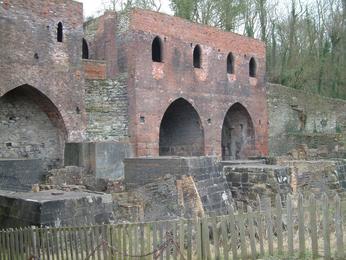 years further along the gorge before being moved here. Along the valley is a typical cottage, or hovel of the poor, with chickens and pigs. Next down the valley is the old Toll House, renovated. It stood on the old A5 and is a relatively pleasant home, because Telford decided giving the toll keeper decent surroundings would “keep them honest”. All cottages have fires, very welcome relief from the bitter wind. Beyond is a corrugated iron church. These churches could be purchased from stores such as Harrods and came “flat pack” style. They were built close to the works, or in this case, the pit head, to catch the workers before the pub did!
years further along the gorge before being moved here. Along the valley is a typical cottage, or hovel of the poor, with chickens and pigs. Next down the valley is the old Toll House, renovated. It stood on the old A5 and is a relatively pleasant home, because Telford decided giving the toll keeper decent surroundings would “keep them honest”. All cottages have fires, very welcome relief from the bitter wind. Beyond is a corrugated iron church. These churches could be purchased from stores such as Harrods and came “flat pack” style. They were built close to the works, or in this case, the pit head, to catch the workers before the pub did!
Iron Bridge – The small town of Iron Bridge stands on the banks of the Severn where the world’s first cast iron 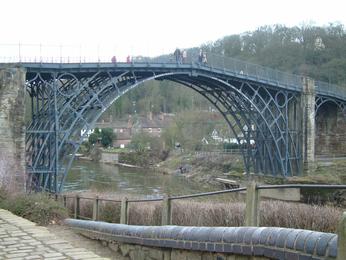 single arch bridge was constructed. Architect Thomas Farnolls Pritchard proposed a single-arch bridge that would span the gorge in 1773. As arch bridges do not require supporting piers, the bridge would not block the passage of boats on the busy waterway. Sadly, Pritchard died in 1777, before the bridge was built, so local businessmen commissioned Abraham Darby III, a local ironmaster, to complete the bridge. The bridge’s arch spans 100 feet and has five arch ribs, each cast in two halves. However, the details on how the bridge was actually constructed were lost for many years and it was not until 1997 that a small watercolour by Elias Martin was found in Stockholm which showed the bridge under construction. This gave enough clues for a team to build a half sized reconstruction at Blists Hill and rediscover the ingenious techniques used. The original Toll House stands by the bridge. The town is mainly on the other side of the river. A fine hotel faces the end of the bridge and streets of houses rise up the gorge sides, including some especially fine mansions higher up.
single arch bridge was constructed. Architect Thomas Farnolls Pritchard proposed a single-arch bridge that would span the gorge in 1773. As arch bridges do not require supporting piers, the bridge would not block the passage of boats on the busy waterway. Sadly, Pritchard died in 1777, before the bridge was built, so local businessmen commissioned Abraham Darby III, a local ironmaster, to complete the bridge. The bridge’s arch spans 100 feet and has five arch ribs, each cast in two halves. However, the details on how the bridge was actually constructed were lost for many years and it was not until 1997 that a small watercolour by Elias Martin was found in Stockholm which showed the bridge under construction. This gave enough clues for a team to build a half sized reconstruction at Blists Hill and rediscover the ingenious techniques used. The original Toll House stands by the bridge. The town is mainly on the other side of the river. A fine hotel faces the end of the bridge and streets of houses rise up the gorge sides, including some especially fine mansions higher up.
Coalport – Back eastwards along the valley is Coalport, which gave its name to one of the famous names in English pottery. Ceramics had been produced here since Roman times. In 1772, Thomas Turner began working for Ambrose Gallimore in a pottery at Caughley. Turner became renowned for his high quality work, mainly in unglazed biscuit ware in the Chinese fashion. One of his apprentices was the talented John Rose. He set up business with Edward Blackway at Jackfield in 1793 and moved across the Severn to Coalport in 1795. This business became very successful, attracting the attention of the Prince and Princess of Orange in 1796, who visited and purchased some examples. The factory ceased production in 1926, although the Coalport name remains alive as part of the Wedgwood group. The museum contains many examples of Coalport ware, although much of it is of a Victorian design that finds little favour with me! Other parts of the pottery have exhibits on the making of ceramics.
Monday 23rd February – Birmingham – Off to the Jewellery Quarter, which is a fair walk from the city centre. We visit the Royal Birmingham Society of Artists which has an excellent display of local art, jewellery and ceramics. Then on to St Paul’s Church, built in 1779 by James Gibbs in the “Neo-classical” style, which was the radical new look for that period. It is built of brick and faced with stone from Bilston in the Black Country. Cast iron columns came from the Darby foundry in Coalbrookdale and are contemporaneous with the Iron Bridge (see above). Wooden enclosed pews are still in place and were paid for by individuals – Matthew Boulton held pew 23, James Watt (who never attended) had pew 100. There is a superb East window by Francis Eginton depicting the “Conversion of St Paul”, painted in 1789. The church, which had held concerts by Mozart had, by 1945 become a shabby ruin, damaged by bombing. There was a distinct possibility that it would have been razed but for the efforts of Ralph Stevens who saved this fine building. The Jewellery Quarter is now several streets away and is a mass of jewellers and artisans shops. It is hard to imagine how many of them actually make a sale every day. A fine Victorian clock tower stands at the cross roads. At the station is a cast iron (with fine filigree) “pissoir” of the Paris style. Inside the ceramic is badly chipped and it smells pretty appalling, but is very functional.
which has an excellent display of local art, jewellery and ceramics. Then on to St Paul’s Church, built in 1779 by James Gibbs in the “Neo-classical” style, which was the radical new look for that period. It is built of brick and faced with stone from Bilston in the Black Country. Cast iron columns came from the Darby foundry in Coalbrookdale and are contemporaneous with the Iron Bridge (see above). Wooden enclosed pews are still in place and were paid for by individuals – Matthew Boulton held pew 23, James Watt (who never attended) had pew 100. There is a superb East window by Francis Eginton depicting the “Conversion of St Paul”, painted in 1789. The church, which had held concerts by Mozart had, by 1945 become a shabby ruin, damaged by bombing. There was a distinct possibility that it would have been razed but for the efforts of Ralph Stevens who saved this fine building. The Jewellery Quarter is now several streets away and is a mass of jewellers and artisans shops. It is hard to imagine how many of them actually make a sale every day. A fine Victorian clock tower stands at the cross roads. At the station is a cast iron (with fine filigree) “pissoir” of the Paris style. Inside the ceramic is badly chipped and it smells pretty appalling, but is very functional.
Wednesday 25th February – Home – Overnight we had the heaviest snowfall of the winter, although it still amounts to little more than a thin coating. Foot prints across the lower patio indicate a relatively large animal has passed in the night; probably a Fox. (Looking at the prints further and more on Friday seems to indicate a cat is more likely.)
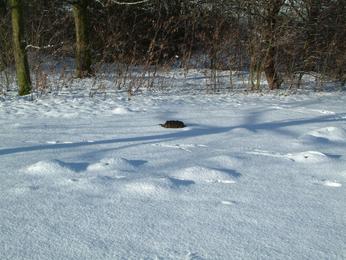
Friday 27th February – Darton – A much heavier snow fall occurs overnight with a covering of several inches. Dill the Dog and I head out beside the River Dearne from the village centre. A Robin is puffed up like a little ball. Bird song is still everywhere despite the bitter conditions, although the brilliant sunshine is warming things up. Molehills covered in snow look like little igloos. One is very fresh and a pile of dark soil rises above the snow. In the woods beyond the park, Fox and Rabbit tracks abound.
Saturday 28th February – Fleets Dam – A large log is sticking out of the water beneath the weir. It is clearly much larger than the visible piece as the water is pounding it yet it remains stuck fast. Its source is apparent slightly further upstream; a chainsaw has been busy clearing the fallen and broken Willow branches. However, the flow of water in the river is insufficient to clear the rafts of rubbish. This is somewhat surprising given the amount of snow that has fallen, but maybe little has melted out in the fields. A Grey Wagtail bobs around on the rubbish. The lake is grey, reflecting the steely sky. Black-headed Gulls circle; very few have gained their black heads yet. The usual clamour of bird calls and song are strangely missing, just the occasional squeak from a Blue Tit. Maybe they are foreseeing more snow? The fishing platforms at the South end are still covered with snow. Grey Heron footprints are present on most of them. The pattern is consistent, the heron lands on one edge then walks around, turning 360° to face the lake.